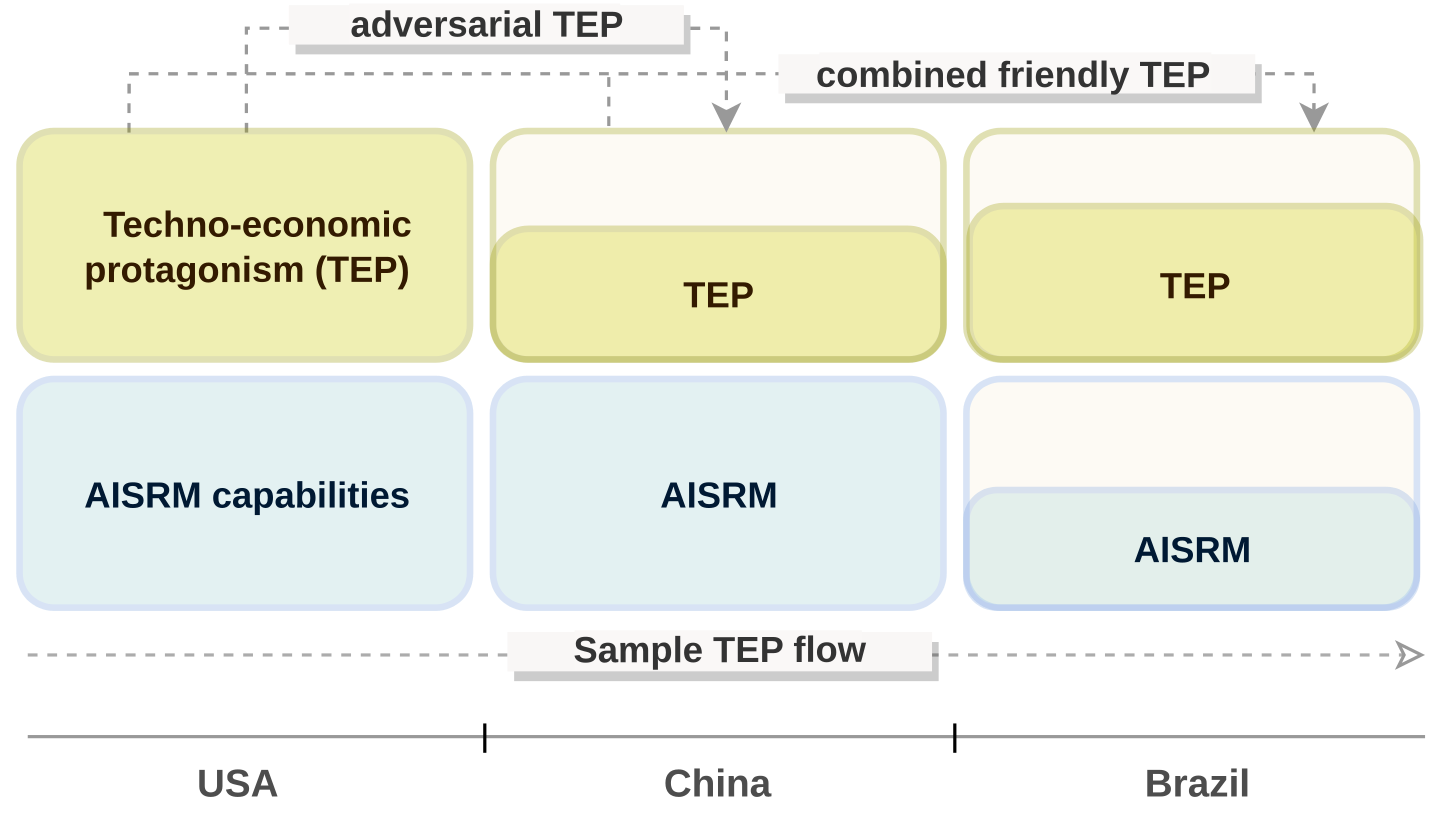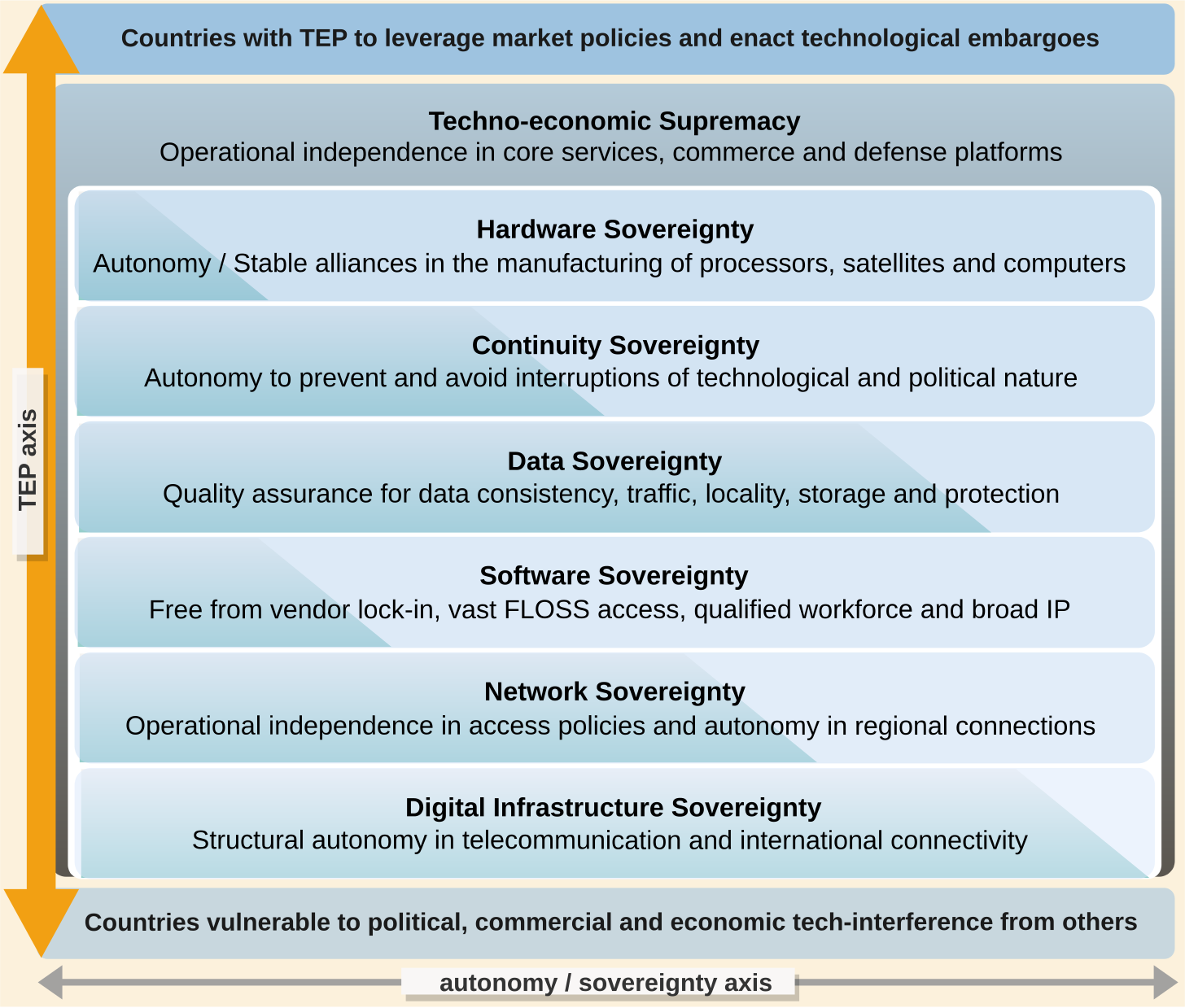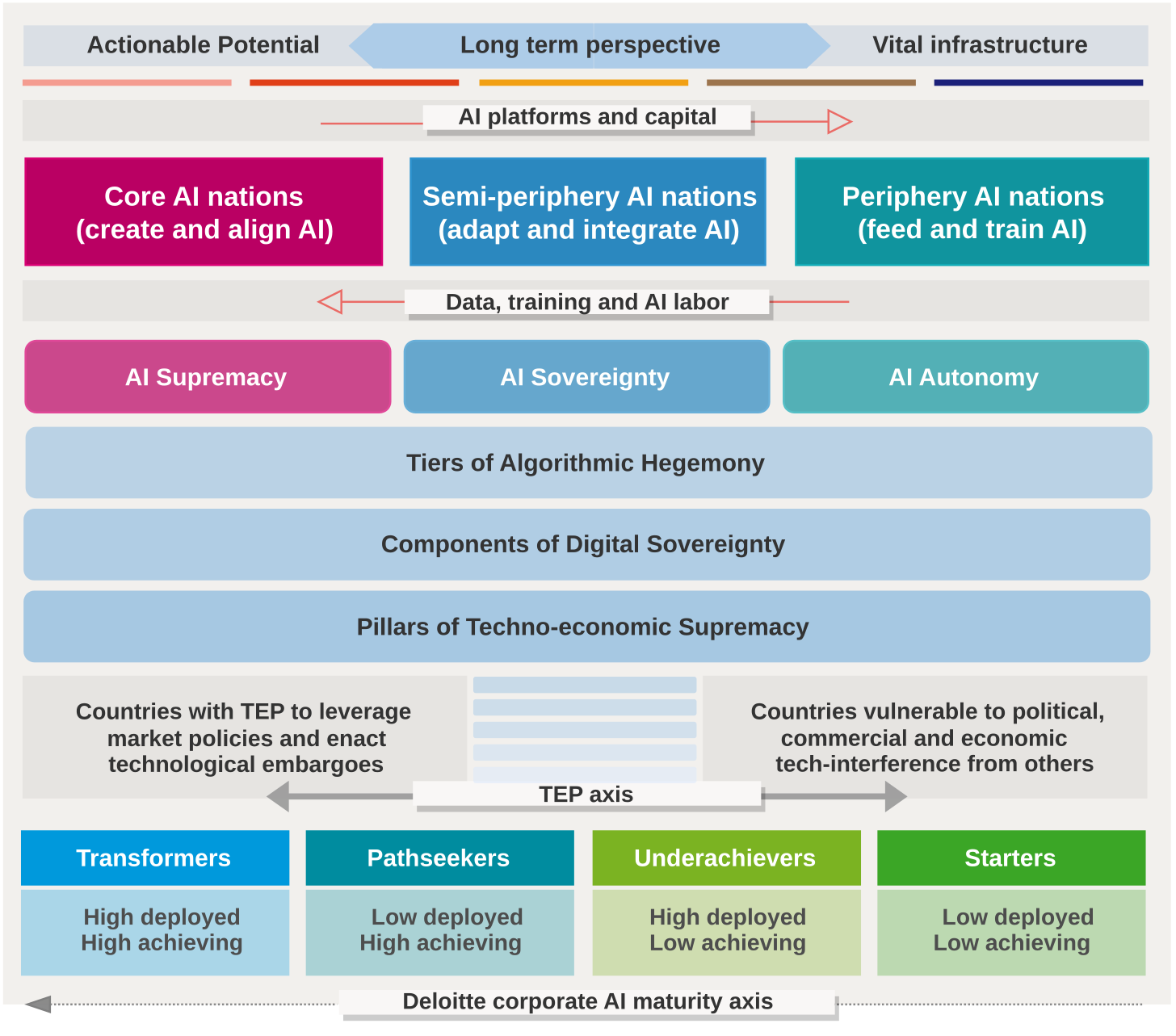Techno-economic protagonism and AI core-periphery power dynamics
Revisiting nation-state power dynamics in the AI era
Update (May 10, 2024): A new article about the Techno-economic protagonism (TEP) is now available. It elaborates on TEP’s ontology and presents the Digital Powercube framework, a tool that allows for both TEP Analysis on techno-economic inquiries and state level relations of Digital Power, including instructions on how to use LLM prompts to test its normative and descriptive capabilities. Access it here:
Abstract (generated by Claude.ai). This article introduces the novel concept of “techno-economic protagonism” (TEP) as a measurement of a nation's ability to exert power and influence through the strategic deployment of sovereign infrastructure and AI. It proposes frameworks for evaluating national AI readiness and capabilities, including the AI Strategy Readiness Model (AISRM) and the AI Core-Periphery (ACP) framework which examines the dynamics between “Core AI nations” driving AI innovation and “Periphery AI nations” largely providing data and labor. Building on this core-periphery dynamics, the article outlines a stratified hierarchy spanning true components of digital sovereignty, pillars of techno-economic supremacy, and tiers of algorithmic hegemony ranging from AI autonomy to full AI supremacy. Ultimately, it argues that maximizing techno-economic protagonism by achieving digital self-determination across this hierarchy is crucial for nations to maintain welfare and true autonomy in an AI-driven era of shifting nation-state power dynamics.
So much is talked about AI nowadays and yet, countries are still unsure on how to tackle commercial AI issues or agree on its very own governance models, but even less is talked about how AI empowers (or weakens) a nation’s power projection capabilities.
As AI continues to transform businesses and personal interactions, its impact on nation-states politics is an inevitable consideration. The field’s evolving landscape suggests that changes to the dynamics of Game Theory at the macroeconomic and state intelligence levels are on the horizon and yet, discussions on these implications are very underwhelming given the complexity of the issues at hand.
All things considered, it is my opinion that in a very broad convention, whenever talking about Intelligence AI and Defense AI literally ALL countries adhere to this sort of “AI Sinatra Doctrine” (making an analogy to its “my way” anecdote and the field minimal constraints from oversight, regulations or even binding agreements,) and while all the autonomy and secrecy around these developments might eventually catch countries like deer staring at headlights, today I’ll talk about related tendencies taking place right now, namely: “Digital Autarky, Techno-Nationalism and Strategic Autonomy Doctrines”, quite parallel conversations that to me are all related to how nation-state power dynamics are expressed nowadays, particularly regarding AI interests, aspirations and capabilities.
I have no intentions to be definitive in any way here, but I feel there is a void in the AI era of power projecting capabilities, implications and effects, so I’m kicking off this ball.
In order to address how AI affects nation-state power projection resources, I still have to briefly cover today’s AI regulations and governance models because we need to set the stage for everything else here, so let’s get this going:
In a recent collection of papers published by the WEF titled “AI Governance Alliance: Briefing Paper Series”, Larsen et al.1 included the following interesting table on AI governance approaches:
My personal takeaway is simple: there isn’t a standard. And while some people will argue all day about this if you give them a “good morning” facts are facts: is the standard in the room with us? No.
And given how governance of national Digital Strategies gets done around the world, no one is safe from asymmetrical governance approaches. Gierten & Lesher2 published this one paper titled “Assessing national digital strategies and their governance” in 2022, but I think the facts illustrated on this excerpt still stand, notice how columns look the same height:
By this point we should be pretty much leveled here: there isn’t a standard. No country knows who’s responsible for Digital, no country knows the best governance model for AI, no classic “Brussels effect” has taken over the governance of digital things just yet, so it seems we can quite safely assume AI inherits this “dynamic” in the world of politics, policy-making, governance but... power dynamics are a different beast.
As far as I can tell, the UAE is still the sole country with a dedicated Minister of State for AI, and time will tell if this was the right approach (hint: it is,) and that’s the point here: treating AI as merely another digital initiative overlooks its pivotal impact for this decade we’re in, and in order to comprehend how AI dynamics are unfolding in the global fora, one thing must be clear: We are living in the era of a new “soft power”.
So to frame everything that follows, let me introduce you to a new terminology I crafted for this particular phenomena, I call it: “Techno-economic protagonism” or TEP for short. You can search it on Google Scholar, Google Books, JSTOR, Bing it, I’ll wait. Zero results, right? It is either brand new and I am forging it, or eventually some redditer will prove me wrong, but as of today: finders keepers, it’s mine.
There is a true academia friendly foundation on how this term came to be, that I shall elaborate in another post but to keep things simple, I am just going to offer an example of the TEP power, that hopefully should get you up to speed.
To paint a clearer picture on how the basics of TEP projection works, I first have to use an AI readiness model, so I did one myself using a simple Maslow pyramid like diagram to explain the obvious nation-state building blocks of an “AI autonomy” for National AI Strategies, for now it is called “AI Strategy Readiness Model” (or AISRM):
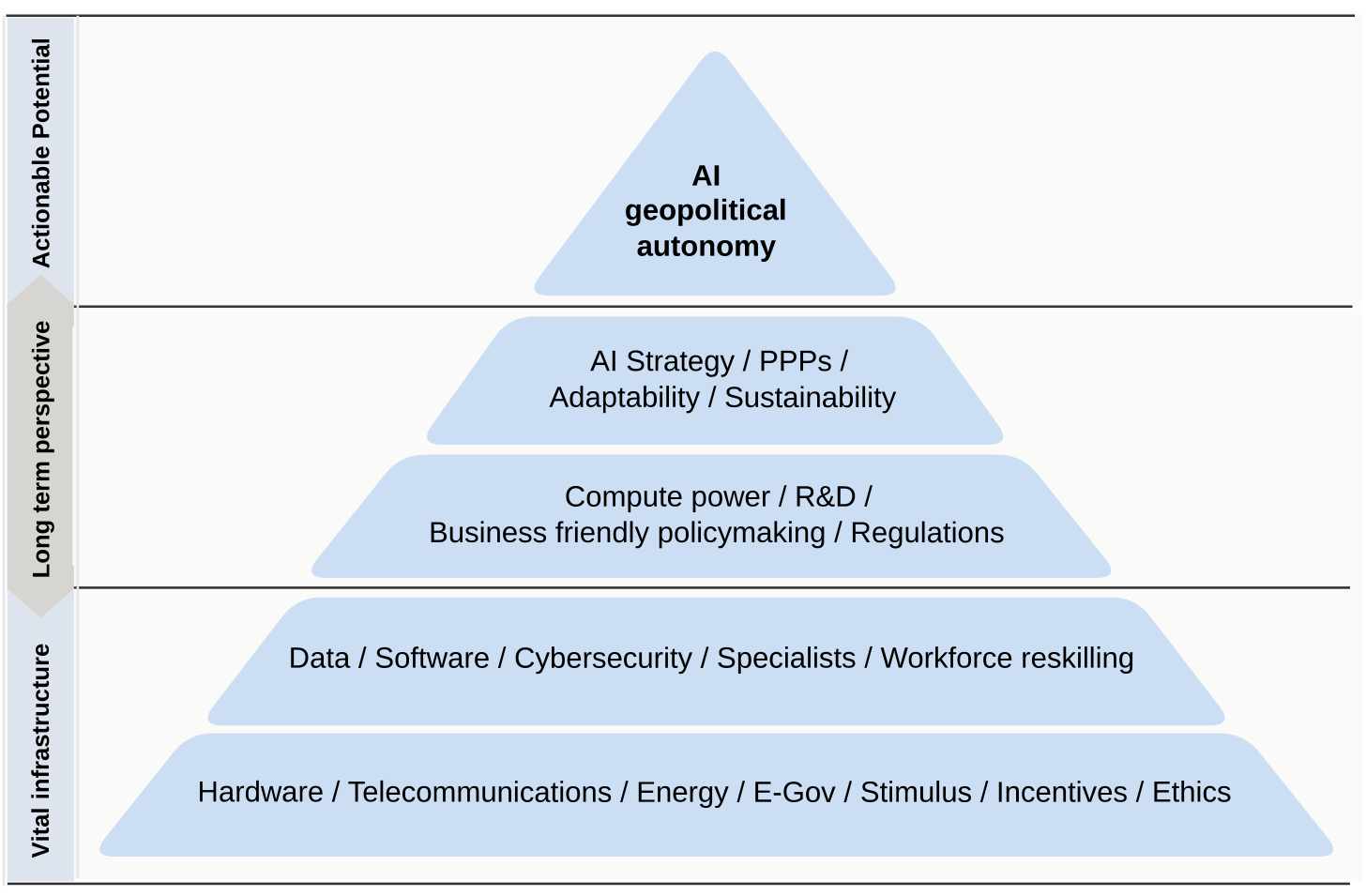
At this stage it is very important to have such model in order to learn about two core axioms in the search of what I call here “Algorithmic Hegemony”:
The sum of all structural capabilities at the AISRM lower axis does not make a nation into an AI sovereign nation;
Confluence and synergy between AISRM middle and bottom axis does not turn a nation into an AI sovereign nation either;
While having the national capabilities to develop effective policy-making, coupled with strong governance to leverage the various [non-exhaustive] assets outlined in the AISRM can indeed lead a nation to be considered an “AI leader,” this achievement alone represents only what I define as one “AI autonomy.”
The distinction is necessary so we may have a common classification of AI hegemonic states, a concept that I perceive as threefold: “AI autonomy”, followed by an “AI sovereignty” to finally have the title of an “AI Supremacy” allocated for nation-states that maybe one day achieve what I call “Techno-Economic Supremacy”. We’ll be back to this one, hold that thought. For now, lets round back on the TEP projection.
Now that we have the AISRM to seize state AI readiness in a broad convention model, let’s have an anecdote to illustrate how Techno-economic protagonism takes place as a novel soft power unit for and of our times.
Let’s put together the two AI leaders of the world, namely US and China, together with my home country in a diagram:
While Brazil isn’t even remotely close to have the AISRM capabilities might of its peers, Brazil does displays more TEP than China. This happens because the United States projects its TEP over China in a more adversarial approach (via export controls, de-risking policies, sheer adversarial mindset, etc.,) than it does to Brazil. As Brazil enjoys friendly techno-economic relations with both nations, its combined TEP excels over nations under more adversarial TEP pressure.
Two key points emerge:
The TEP encompasses a nation's traditional soft power elements, its techno-economic strategies and internal incentives, layered with the global soft power projection of its digital leaders (eg. Google in the US and Tencent in China);
Owning advanced digital capabilities does not guarantee a high TEP, as it is influenced by the TEP of other nations as an unit of techno-economic primacy, or here, protagonism. For example, while using a domestically-developed search engine would indeed strengthen Brazil's own TEP, in the real world Brazil uses mostly Google and not Baidu, which ultimately strengthens US TEP, not China's.
TEP acknowledges that traditional soft power dynamics persist in today's world, while also recognizing the broad influence of techno-economic leaders projecting AI power dynamics inextricably tied to their home countries' geopolitical interests and legal frameworks as an undeniable reality. Consequently, a new conceptual metric emerges: The TEP aims to unify these dynamics into a cohesive narrative of a techno-economic soft power primacy. Over the years, in an increasingly AI-driven world, TEP should not only reflect a state’s techno-economic power projection, but also expose the broader dynamics and consequences of its influence.
And in order to understand how such influence takes place and name these dynamics, we need yet another model. Luckily, I got just the thing.
Having established an up-to-date conceptual metric for today’s power dynamics, we can now delve into the next model to comprehend how the de facto AI power dynamics are unfolding globally. Framing the current state of affairs serves as the initial step towards progressing in the right direction, and while this analysis is not fatalistic, as you’ll see it does follows a quite pragmatic perspective.
Here, I revisit Immanuel Wallerstein's World-systems theory3, a classic narrative of transnational economic power dynamics. This framework offers me a strong foundation to illustrate the interrelationships of techno-economic power shaped by the TEP. Building on this concept, I introduce the AI Core-Periphery Framework (ACP for short), inspired by World-Systems analysis main divisions
The basic flow of the ACP diagram should be self explanatory: Core AI nations project AI platforms and capital, receiving data and labor value in return from Periphery and Semi-Periphery AI nations.
Basic features outlined on this trichotomy elucidate the primary characteristics of each stratum: Core AI nations develop, distribute, and align their AI platforms based on their values and policies; Semi-periphery nations then assume the responsibility of providing market-specific details for the integration and adaptation of AI platforms into specific market capabilities and legal frameworks, serving as a facilitator between the extremes of the ACP. This leaves Periphery AI nations to mainly provide data, Reinforcement Learning and Human Feedback efforts, and sheer labor resources.
But let’s not stop there. The ACP can be extended with a vertical axis for each element of the trichotomy in order to outline key attributes, possible potentials and vulnerabilities associated with each stratum, so let’s do it:
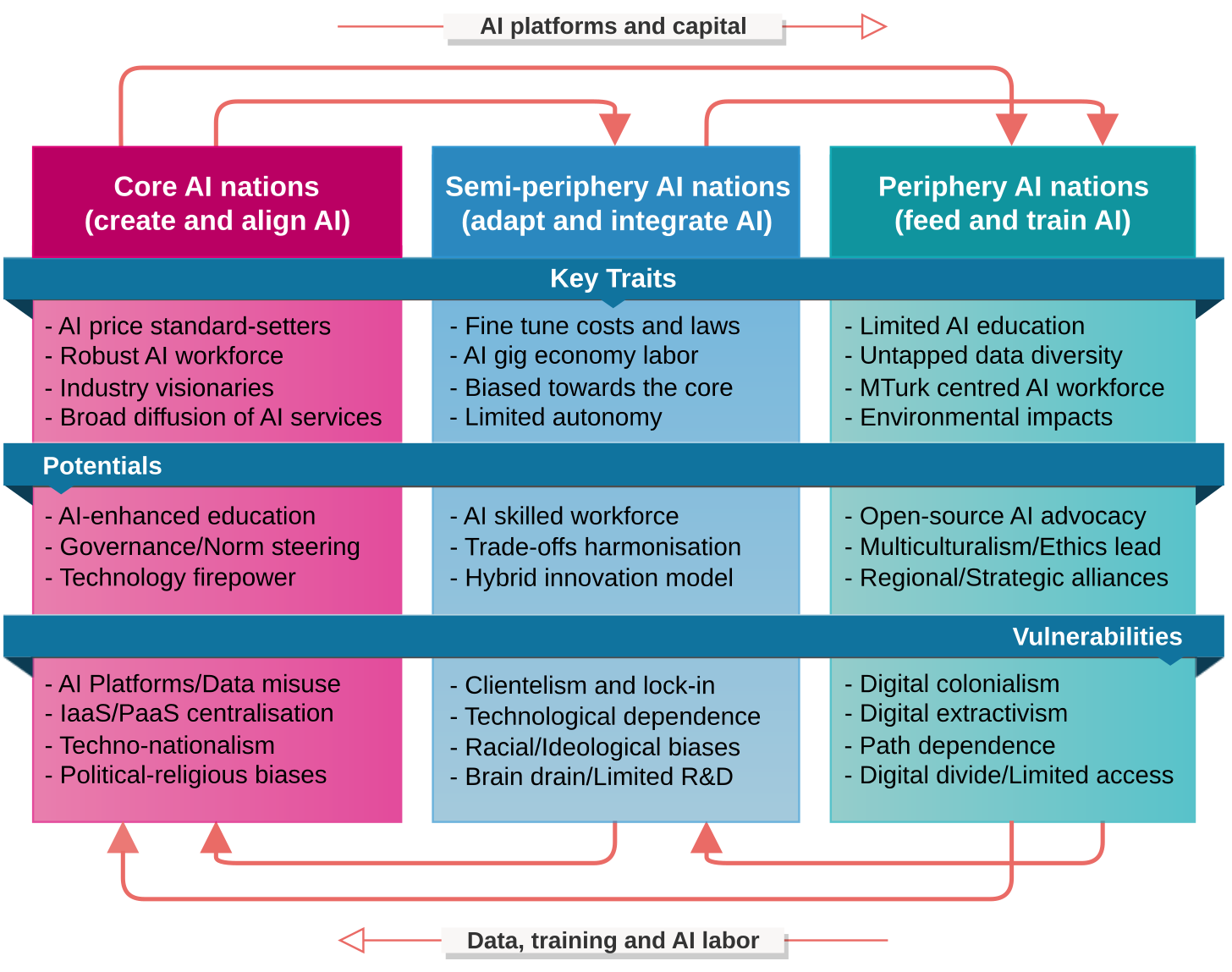
Outlined by the extended ACP are prospective elements divided into three categories akin to a quasi-SWOT analysis, namely: key traits, potentials, and vulnerabilities. These categories representing common attributes across the entire strata (Core, Semi-Periphery, and Periphery AI Nations), illustrate the inherent conditions, threats and opportunities that shape ACP dynamics at a particular moment in time, quite similar to how Wallerstein's own TimeSpace concept4 considers historical context and hierarchies. This approach underscores the dynamic nature of ACP's prospective elements: They capture a temporal snapshot of the interplay between classic and contemporary power structures, enabling the ACP to be applied for the modeling of historical, current, or future interactions within its core divisions.
So now we have a timeless power dynamics framework to seize how AI introduces and reinforce power relations between nation-states, where the TEP of nations to the left is inherently asymmetrical towards the TEP of nations to the right, perpetuating traditional hierarchies and soft power dynamics.
However, it becomes quite clear that AI raises several important implications for the relationship between different actors in the global power landscape, where no entity is shielded from the impacts of such relations. Over time, prospective elements may become critical or turn into positive outcomes, but for now, the ACP offers a birds-eye view of real world power dynamics between AI “have/have nots”, which should be a good starting point for the normative and academic discussion of such dynamics.
But how can nations move between these tiers? Are Periphery AI nation-states fated to a relationship of servitude to Core AI nations? How can Semi-periphery nations avoid becoming a digital colony or an AI vassal state to another? In order to understand how this movement can take place and how a nations TEP can become a tool for such movement, we gotta go back in time, McFly!
It is my understanding that nowadays the word “sovereignty” has been hijacked by commercial narratives, particularly regarding cloud services (namely IaaS, PaaS and SaaS, for the initiated). And I am quite confident this is not by mistake: Nations with a more expressive TEP also happen to sell “sovereignty” to others, which may or may not indicate the use of classic and contemporary geopolitical power dynamics, but that’s a conversation for another day.
My concerns with the commercial concept of “digital sovereignty” are twofold:
Can it genuinely be considered a sovereign capability if it fails to enable customers to develop the know-how and skills necessary to create these sovereign services, instead merely allowing them to use them? Wouldn't this potentially lead to a “brain drain,” drawing top talents from all jurisdictions where these sovereign services are offered, ultimately funneling them into the job markets of de facto digital sovereignties?;
Is it truly sovereign if from a legal standpoint, the legal frameworks of the providers can eventually take precedence over those of their customers? While contracts, MoUs etc., are in place, we are talking about sovereignty, right? If customer country Z elects a new president that provider country B doesn’t like, export controls can be enacted and well, will contracts still hold? We can see here the rationale of Digital Autarky, Techno-Nationalism, de-risking and strategic autonomy doctrines.
Nations have been “kicking the can down the road” when it comes to acknowledging de facto sovereignties in digital matters for quite some time and this delay was largely due to necessity, as these nations had to “Digitally Transform" themselves. But this isn’t about shielding digital markets or data transfers, you can’t just use SCCs and BCRs, forge a new “Privacy Shield” and say “sovereignty is being respected here” when the topic is true sovereign infrastructure. We can’t just award an AWS certificate to an Irish expert and not tell people that digital sovereignty here is American and not Irish.
Indeed something doesn’t feel right from the social sciences perspective when a sovereign nation isn't truly sovereign, but it seems quite evident that we should also aim to avoid adversarial thinking, hostile protectionist policies and retract from globalization progress.
A more nuanced approach should allow everyone to be strategic and avoid the overuse of terms like “Cyber Sovereignty” and “Techno-Nationalism,” so that nations may pursue autonomy within the framework of multilateralism, right?
Wrong.
Contracts of digital subservience to the Digital Sovereignty of another likely occur in the dynamics between Periphery and Core nations, and given AI ever so increasing demand for localized computing power, states are not exactly misguided on the search for “de-risking” policies and the aforementioned doctrines. Core AI nations won’t start enacting policies against their TEP, what we see in the real world is quite the opposite5. Perhaps the end game here lies beyond the us-versus-them mentality.
In the pursuit of self-determination, it is imperative to adopt a perspective that enable nations to fully realize their sovereign capabilities, thereby empowering statecraft with the necessary foresight for informed progress. Hence it’s crucial to differentiate between market oriented Digital Sovereignty capabilities and the majority of its most common assets which primarily address digital governance concerns in civilian and commercial spheres, from what I consider to be true TEP enablers of a “Techno-economic Supremacy”.
Many of the assets outlined in the Techno-economic Supremacy Pillars diagram are well known elements in commercial dialogues surrounding Digital Sovereignty. However, here they are all encompassed within the purview of the TEP axis. As the diagram illustrates, top TEP nations have significant leverage over nations with a lower TEP, akin to the dynamics seen in Core-Periphery relationships. Such hierarchy also exposes how countries at the lower end of the spectrum are more prone to techno-economic interference from either Semi-periphery or Core AI nations.
Similarities aside, TEP is purposely chosen as the axis here just so I can better illustrate how TEP projection empowers nation-states to use critical really sovereign assets as tools to navigate previous AI Core-Periphery tiers exposed in the ACP framework.
Distinct from all other elements in the diagram, is the Techno-economic Supremacy layer at the top. All other elements are indeed enablers of a more influential TEP and true nation-state digital self-determination tenets, and the practical distinction between autonomy and sovereignty in each layer is then linked to how many of the listed sovereignties a nation have as “in-house sovereignty”, where less means more autonomy (thanks to commercial relations,) more means both more autonomy and sovereignty over a specific layer. But be it in full or in partials, when summed up these individual sovereignty layers stack up for a state of supremacy over other less capable nations, here exposed as nations with less influential TEP projection.
A nation attains Techno-economic Supremacy when it achieves full operational independence from other nation-states in building and operating its core services, commerce and defense platforms, without exceptions. As a true Digital Hegemon, such a nation is expected to possess nearly full Hardware Sovereignty capabilities, which is the most challenging to achieve, as it demands either complete domestic manufacturing capabilities for all digital services or very stable alliances with provider allies.
To provide a well-rounded view, I believe it is proper not to forget legacy Digital Sovereignty elements in this narrative, specially given how relevant these all are for today digital dynamics and the future of AI, so you guessed right, I have yet another model and this one’s a mouthful: “The Stratified Hierarchy Model of Techno-Economic Supremacy, Digital Sovereignty, and Algorithmic Hegemony” and it looks like this:
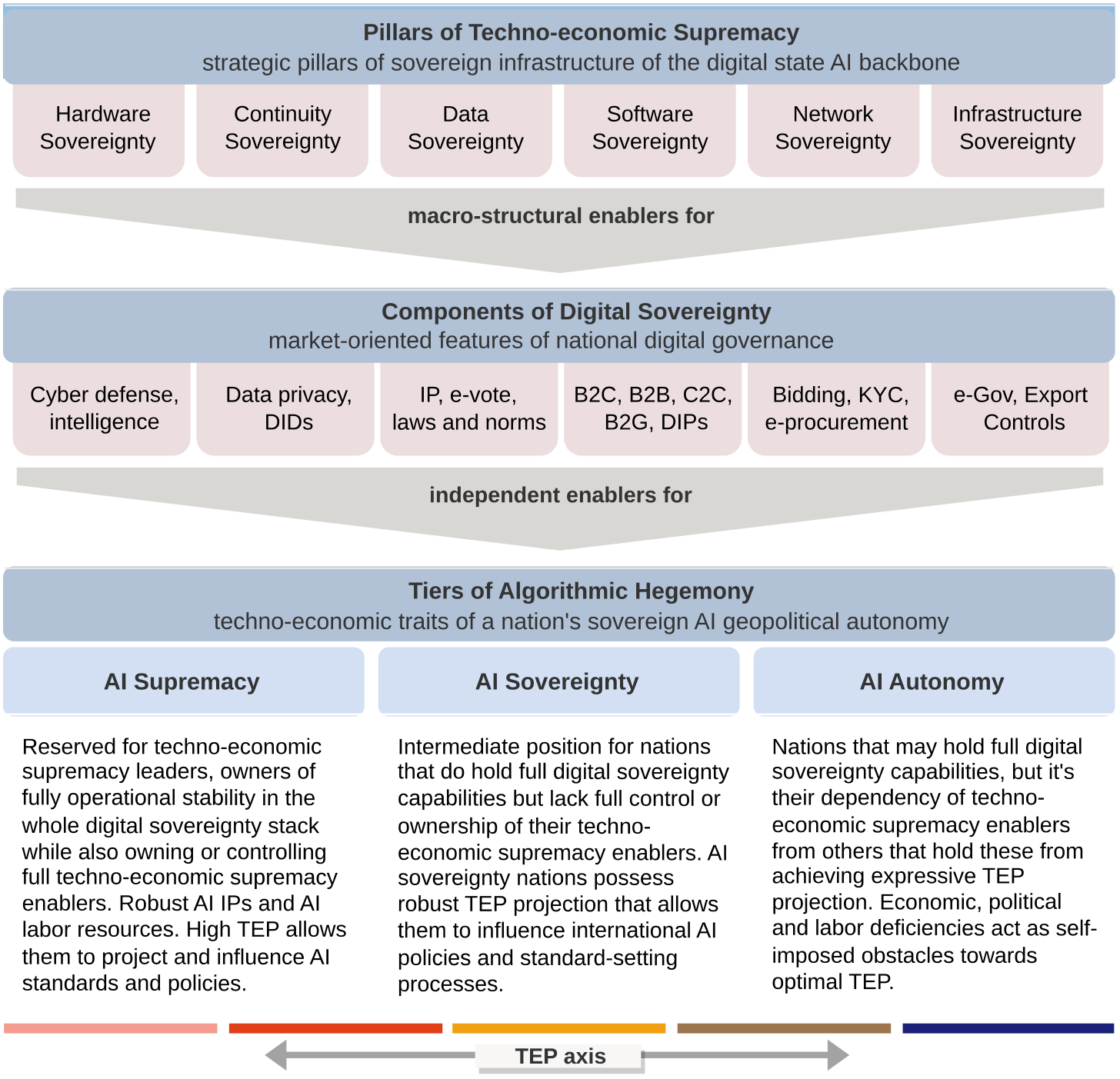
The top layer, “Pillars of Techno-Economic Supremacy,” encompasses the foundational macro-structural enablers, same ones illustrated in the previous diagram, which are exposed here as strategic pillars of sovereign infrastructure of the digital state. In the current state of affairs, these are true macro-structural enablers that allow for a nation to project the most optimal TEP in a global setting.
The middle layer, “Components of Digital Sovereignty,” delves into the specific aspects of governance, regulations, institutional frameworks and control mechanisms that enable a nation to exercise sovereignty over its digital domain, either built upon owning technological foundations as established in the top layer or by relying on such foundations coming from Core AI nations that make these commercially available.
The bottom layer, delineating all three tiers of Algorithmic Hegemony (namely: AI Autonomy, AI Sovereignty, and AI Supremacy), offers a fresh perspective on the levels of control, influence and independence that nations may aspire to in the field of AI. And while these are facilitated by the availability of capabilities from the top layers, it is the overall fused TEP of said capabilities that enables mobility within these tiers.
This hierarchical framing provides a comprehensive and systematic way to analyze and understand the intricate power projection dynamics enabled by technology and the pursuit for sovereignty in the AI era. The model's novelty lies on its holistic yet stratified approach, highlighting the interconnected layers that nations must navigate to achieve technological preeminence and self-determination in an AI-driven world.
These assets transcend mere aspirations as they constitute the combined foundational enablers for the digital state era and act as literal facilitators for in-house AI expertise and availability; Such truly sovereign stack is then what empowers nation-states with genuine autonomy over the control, alignment, and availability of present and future AI systems. Surely, the intention isn’t to foster digital apartheid, as it is my opinion that generally speaking collective doctrines are the smarter bet for a safer future for AI (as technology not as a product,) but the fact is high TEP nations won’t just cease to exist, so it’s up for Semi-periphery and Periphery AI nations to understand and pursue their own sovereignty, given that a stronger TEP is then what either empowers or restrain them in this arena, it is the future of their workforce conditions, and ultimately, their own welfare.
Colors above the TEP axis in the previous diagram are also not there for aesthetics, they represent stages that relate to distinct levels of a nations self-determination towards supremacy, that as of today, can be visualized as so:
It is not a surprise that Core AI Nations have hegemonic aspirations, it is a well known fact that those at the top won’t legislate or scheme against their own status, but to understand this mindset of “Digital realpolitik” is to understand the pragmatism of the AI competitive arena. Robust infrastructure and capabilities, true digital sovereignty, strong alliances and the combined TEP of a nation are indeed what sets apart top tier AI states from others in this new era of power dynamics.
The models introduced thus far are designed to assist policymakers and fellow scholars in framing contemporary power dynamics within the context of the Techno-economic protagonism (TEP) and given that this AI era is centered around sovereign and abundant digital capabilities, it is shallow to continue using outdated concepts and terminologies to describe the inner workings of the world of today. Core AI nations may leverage these frameworks to capitalize on their strengths and address their vulnerabilities and Periphery and Semi-Periphery nations can gain a deeper understanding of the true dynamics of this AI arms race and optimize their strategic capabilities, realign priorities, forge new alliances and demand sharper political action towards self-determination. Additionally, AI end customers can develop a more informed perspective on such dynamics and urge their leaders to prioritize their nation's TEP, as it ultimately defines long-term welfare and true autonomy for their nation's AI trajectory.
On the enterprise domain, Deloitte was using until 2022 in their report “State of AI in the Enterprise”6 an interesting 2x2 matrix model to characterize enterprise AI efforts that I believe remains as one of the most interesting way to address the relationship between developed AI solutions and its outcomes, so that business stakeholders may work on the value of their endeavors. I believe the definitions used in their model to be accurate enough to be used to outline actionable TEP mobility efforts, so if they don’t mind (fingers crossed they won't!), I’ll add such definitions together with the fusion of all the frameworks and models introduced in this article, so we may have this unified model – the TEAS Framework – that captures everything discussed here.
Not every nation needs to achieve AI supremacy. In fact, no nation should sever ties with specialized solutions that can provide value to their businesses and citizens. However it is important to be able to frame TEP projection, to have a normalized terminology that isn’t dictated by commercial solutions in order to better understand what is or isn’t sovereign, and finally, it is of paramount importance for nations to identify the core assets that empowers their nation-building strategic infrastructure, fostering an AI primacy that is truly independent from external influences and limitations, regardless of their nature.
Larsen et al., AI Governance Alliance: Briefing Paper Series 2024. (2024). World Economic Forum - https://www.weforum.org/publications/ai-governance-alliance-briefing-paper-series
Gierten, D., & Lesher, M. (2022). Assessing national digital strategies and their governance. OECD. doi: 10.1787/baffceca-en - https://www.oecd-ilibrary.org/science-and-technology/assessing-national-digital-strategies-and-their-governance_baffceca-en
Wallerstein, I. (2004). World-Systems Analysis: An Introduction. Duke University Press. https://www.jstor.org/stable/j.ctv11smzx1
Wallerstein, I. (1998). Spacetime as the basis of knowledge. People’s participation, challenges ahead, 43-62. | https://mikecas.netsons.org/politica/Note/Wallerstein/SpaceTime%20as%20the%20Basis%20of%20Knowledge.pdf
Atkinson, R. D. (2021). A U.S. Grand Strategy for the Global Digital Economy. Information Technology and Innovation Foundation | ITIF. https://itif.org/publications/2021/01/19/us-grand-strategy-global-digital-economy
State of AI in the Enterprise 2022. (2023). https://www2.deloitte.com/us/en/pages/consulting/articles/state-of-ai-2022.html







